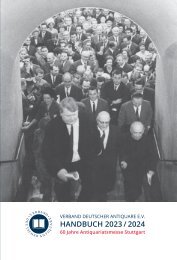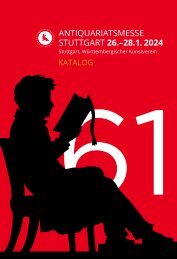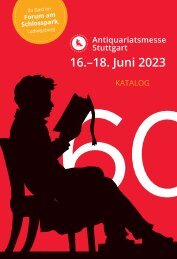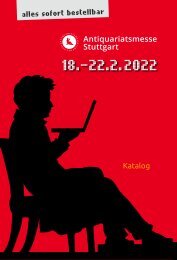Antiquariatsmesse Stuttgart 2021 - Katalog
Katalog zur Antiquariatsmesse Stuttgart 2021: Die Antiquariatsmesse Stuttgart als größtes Schaufenster für wertvolle Objekte des Antiquariats- und Graphikhandels in Deutschland findet in diesem Jahr in ungewohnter Form statt. Da eine Präsenzmesse nicht stattfinden kann, haben sich 76 Kollegen aus Deutschland, Großbritannien, Österreich, Frankreich, der Schweiz, den Niederlanden, den Vereinigten Staaten und aus Australien zusammengefunden, um einen Katalog für die Messe zu erstellen und gleichzeitig ein Angebot für eine virtuelle Messe zusammengetragen. Der Katalog wird am 7. Januar 2021 an interessierte Kunden verschickt, die virtuelle Messe öffnet ihre „digitalen Pforten“ am 29. Januar 2021 um 12.00 Uhr unter www.antiquariatsmesse-stuttgart.de
Katalog zur Antiquariatsmesse Stuttgart 2021: Die Antiquariatsmesse Stuttgart als größtes Schaufenster für wertvolle Objekte des Antiquariats- und Graphikhandels in Deutschland findet in diesem Jahr in ungewohnter Form statt. Da eine Präsenzmesse nicht stattfinden kann, haben sich 76 Kollegen aus Deutschland, Großbritannien, Österreich, Frankreich, der Schweiz, den Niederlanden, den Vereinigten Staaten und aus Australien zusammengefunden, um einen Katalog für die Messe zu erstellen und gleichzeitig ein Angebot für eine virtuelle Messe zusammengetragen.
Der Katalog wird am 7. Januar 2021 an interessierte Kunden verschickt, die virtuelle Messe öffnet ihre „digitalen Pforten“ am 29. Januar 2021 um 12.00 Uhr unter www.antiquariatsmesse-stuttgart.de
Sie wollen auch ein ePaper? Erhöhen Sie die Reichweite Ihrer Titel.
YUMPU macht aus Druck-PDFs automatisch weboptimierte ePaper, die Google liebt.
Perpetual Calendar. A Brass, Silver and Ivory
Perpetual Calendar and Aide-Memoire. Unsigned,
German, circa 1700. The six ivory plates with brass
guards well engraved with acanthus scrolls and heraldic
motif of three boar’s heads, each side mounted
with silver volvelle with apertures, 2 ¾ by 1 ⅞ in (7
by 4,8 cm). € 4500,–
Ptolemaeus, Claudius & Bernardus Sylvanus.
Liber geographiae cum tabulis et universali figura
et cum additione locorum quae a recentioribus reperta
sunt. Venice, Jacobus Pentius de Lencho, 1511.
Folio atlas (425 by 292 mm), title in red, poem on
verso printed in red and black, 6 pp. preliminary
text printed in red and black, 115 pp. text printed in
red and black with four woodcut and letterpress diagrammatic
illustrations, 28 woodcut maps printed
in red and black (each double-page with all but the
final world map in two sections on facing pages),
[4]; A8, B–H6 (first leaf of G unsigned), I8 (first
leaf unsigned). Contemporary calf, gilt borders
and central gilt device, spine with compartments
in gilt, a little rubbed, but a very attractive fresh
copy. € 160 000,–
A very fine example of the Venetian edition of Ptolemy’s
„Geographia“. This is the first illustrated edition
of Ptolemy’s work in which an attempt was made to
update the information given on the maps, and the only
Italian edition of Ptolemy to feature woodcut maps.
Richardson, Sir John, William Swainson & William
Kirby. Fauna Boreali-Americana, or, The Zoology
of the Northern Parts of British America:
containing descriptions of the objects of natural history
collected on the late northern land expeditions,
under command of Captain Sir John Franklin, R. N.
London: John Murray, Richard Bentley and Josiah
Fisher, 1829–1837, 4 vols. 4to, (275 × 200 mm), Contemporary
red half morocco gilt, with 110 engraved
plates of which 72 are hand-coloured, a very nice
large uncut copy. € 33 000,–
Scarce complete copy of the first edition of this rare
work on the natural history of the Arctic. – Sir John
Richardson (1787–1865), surgeon, naturalist and Arctic
explorer, went on Sir John Franklin’s first two Arctic
expeditions as ship’s doctor and naturalist, made observations
and collected a large number of plant and animal
specimens from the Canadian Arctic.
Valk, Gerard and Leon. Uranographia / caelum
omne hic Complectens / Illa pro ut aucta / et ad
annum 1700 Completum / magno ab Hevelio / correcta
est / its, ejus ex Prototypis / sua noviter haec
Ectypa / veris Astronomiae cultoribus / exhibet et
conserant / Ger. et Leon Valk / Amstelaedamenses /
Cum Privilegio. 1700. A Fine 31cm Celestial Globe.
The sphere applied with printed and hand coloured
gores with the stars highlighted in gold, the globe
adorned with celestial figures, mounted in original
brass meridian divided into four quadrants on the
original stained oak stand, with four columns, supporting
horizon ring applied with calendar, zodiac,
and degree scales. € 30 000,–
The pageant of resplendent imagery featured on this
celestial globe is derived from the celebrated work of
the Polish astronomer Johannes Hevelius, the Uranographia
(1687). A total of fifty-four stars and celestial
groups, beautifully touched in gilt, are labelled, while
the forty-eight Ptolemaic constellations and four of the
modern constellations are depicted. Three southern
constellations are featured, in addition to the Milky
Way and the Magellanic clouds. A magnitude table
is included, located below Corono Australis within a
cartouche surmounted by the Sun.
Regiomontanus (Johannes Müller, 1436–1476).
Kalendarius Teütsch. Augsburg: [J. Sittich], January
1514. Quarto (210 × 155 mm). Title within four-part
woodcut border, 87 woodcuts, 10 of these large
including 1 full page lunar figure, numerous initials,
all in bright contemporary hand-colour, with
working volvelles. Contemporary quarter pigskin
over wooden boards. € 25 000,–
A rare, richly illustrated calendar from the Augsburg
Renaissance. – Printed calendars and almanacs became
extremely popular in the fifteenth century and provided
ordinary people with the basic knowledge required to
plan their daily routines. The market for calendars was
first tapped by Gutenberg, who published a calendar
which calculated the times of new and full moons and
planetary positions, with readings every two to three
days. All earlier calendars, however, were superseded
by those of Regiomontanus (1436–1476) whose calculations
were far more accurate; he recorded several
eclipses of the moon and his interest led him to make
the important observation that longitude at sea could be
determined by calculating lunar distances. Outstanding
also is his observation of a comet in 1472, 210 years
before it was „first“ seen by Halley.
Weigel, Erhard. Speculum uranicum … Frankfurt:
Thomas M. Goetze, (Jena: printed by S. Krebs),
1661, ff. [4], 42, [12] pp., illustration: additional
engraved title and frontispiece, 4 woodcut astronomical
plates and 2 illustrations in text (white
on black), engraved title. Ibid. Fortsetzung des
Him[m]els Spiegels darinnen ausser dem andern
Theil der teutschen Himmels-Kunst vornehmlich
der zu Ende des 1664sten Jahres entstandene und
bis zum Anfang des 1665sten fortscheinende grosse
Comet … beschrieben, [etc.]. Jena: S. Krebs for T.
M. Goetze, [1665], [6], 126, [2] pp., illustration:
engraved frontispiece, folding leaf with woodcut
diagrams on both sides at p. 13, frontispiece. Ibid.
Speculum terrae, Jena: S. Krebs etc., 1665, [6], 100
pp., illustration: engraved frontispiece (world map),
frontispiece. € 7000,–
3 works in one volume, 4to (185 × 130 mm.). English
eighteenth-century mottled calf, gilt spine, blue marbled
edges.
175






